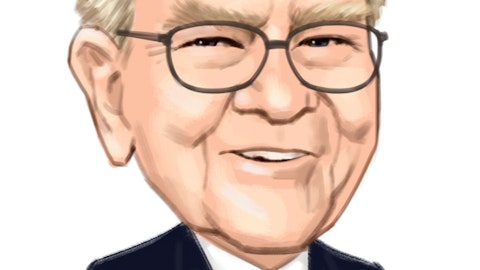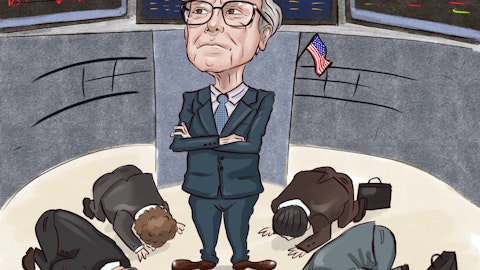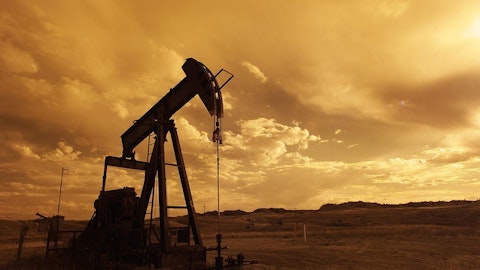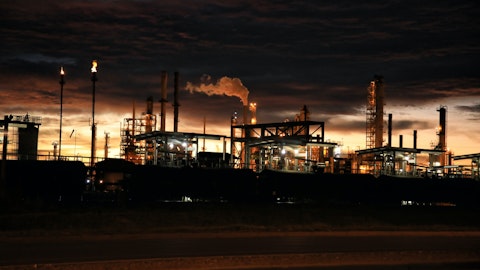Occidental Petroleum Corporation (NYSE:OXY) Q4 2022 Earnings Call Transcript February 28, 2023
Operator: Good afternoon, and welcome to Occidental’s Fourth Quarter 2022 Earnings Conference Call. Please note, today’s event is being recorded. I would now like to turn the conference over to Neil Backhouse, Vice President of Investor Relations. Please go ahead.
Neil Backhouse: Thank you, Rocco. Good afternoon, everyone, and thank you for participating in Occidental’s Fourth Quarter 2022 Conference Call. On the call with us today are Vicki Hollub, President and Chief Executive Officer; Rob Peterson, Senior Vice President and Chief Financial Officer; and Richard Jackson, President, Operations, U.S. Onshore Resources and Carbon Management. This afternoon, we will refer to slides available on the Investors section of our website. The presentation includes a cautionary statement on Slide 2 regarding forward-looking statements that will be made on the call this afternoon. We’ll also reference a few non-GAAP financial measures today. Reconciliations to the nearest corresponding GAAP measure can be found in the schedules to our earnings release and on our website. I’ll now turn the call over to Vicki. Vicki, please go ahead.
Vicki Hollub: Thank you, Neil, and good afternoon, everyone. On today’s call, I’ll begin with highlights of our 2022 achievements, including an oil and gas update followed by our fourth quarter performance. Next, I’ll discuss our 2023 cash flow priorities, our enhanced shareholder return framework and our 2023 capital plan. Rob will then provide an update on the status and mechanics of Oxy’s preferred equity redemption before reviewing our fourth quarter financial results and 2023 guidance. In 2022, our record net income of $12.5 billion, generated a return on capital employed of 28%, which is the highest return we have achieved since before 2005. We also delivered record free cash flow before working capital of $13.6 billion, which enabled us to retire more than $10.5 billion of debt and to repurchase $3 billion of common shares.
Our return on capital employed was enhanced by exceptional performance as our team set multiple operational and productivity records across our U.S. onshore, Gulf of Mexico and International businesses. OxyChem generated record earnings in our Midstream business approximated guidance. Also in 2022, our high-return Permian production grew by 90,000 BOE per day, propelled by outstanding well results. We delivered our best year ever in Delaware new well productivity, 2022, the seventh year in a row that we were able to increase our average well productivity, as shown in our presentation’s appendix on Slide 29. Our teams accomplished this by applying our proprietary service modeling and completion designs to our high-quality reservoirs. Well performance, along with our Oxy drilling dynamics and logistics efficiencies, enabled us to achieve reserves replacement ratio driven by our capital programs of over 140% at a cost of $6.50 per BOE, which was less than half of our current DD&A per barrel.
With price revisions included, the total reserves replacement ratio was 172%, which increased our year-end 2022 reserves to approximately 3.8 billion BOE. Except for the years of the price collapse in 2015 in the pandemic in 2020, we have replaced more than 100% of our production for at least the last 20 years. With the depth and quality of our shale well inventory and 2 billion barrels of remaining potential in our Permian enhanced oil recovery business, we have the scale to continue our history of reserves replacement. A deep inventory, along with our unique portfolio of short-cycle, high-return unconventional assets paired with low decline conventional assets, OxyChem and our Midstream businesses, we have the capability for long-term sustainability and the flexibility to allocate capital to maximize returns for our shareholders.
In 2022, we also made significant progress in developing the capabilities and assets needed to secure a low-carbon future, which is the other key to our sustainability. We started site preparation on our first direct air capture plant and executed several exciting agreements to sell carbon dioxide removal credits to prospective purchasers and industry — diverse industry sectors. We also secured over quarter million acres of land or approximately 400 square miles to develop carbon sequestration hubs. The fourth quarter of 2022 was a fitting way to wrap up a year of continued operational and financial success. We generated over $2.6 billion of free cash flow, which supported nearly $1.6 billion of balance sheet improvements. We also repurchased $562 million of common shares in the quarter, completing our 2022 share repurchase program.
In our business segments, Oil & Gas approximated the midpoint of guidance, despite winter storm Elias impact. Outperformance from the Gulf of Mexico and Al Hosn partially offset storm impacts experienced in the Permian and Rockies. OxyChem exceeded guidance, driven by stronger-than-expected market dynamics, while Midstream and marketing earnings were within guidance. In December, Oxy participated in the recapitalization of NET Power. This is a technology that generates emission-free power generation and has the potential to accelerate emissions reduction efforts in our existing operations and to supply electricity to our direct air capture plants and sequestration hubs. Ultimately, NET Power could be an important emission-free power generator anywhere that has access to natural gas.
Among the record set in 2022 were lateral lengths in the Delaware Basin, DJ Basin, Oman and most notably in the Midland Basin where our well Lulu 3641 DP exceeded 18,000 feet to become our longest lateral on record. Remarkably, this well was drilled in slightly over 12 days. Milestones like this showcase our team’s focus on safely and efficiently expanding the boundaries of drilling technology. Our teams also achieved an Oxy Delaware Basin record for wedge productivity, averaging a 30-day initial production rate of over 3,000 BOE per day from all wells that came online in 2022. We believe that 2 of our wells in the First Bone Spring in New Mexico and 6 of our wells in the Barnett formation of the Midland Basin achieved initial 30-day production records amongst all operators in their respective formations.
In addition, we are continuing to consolidate acreage via trade that enable more capital-efficient, longer laterals, which help to optimize the required infrastructure. The longer laterals, exceptional well productivity and optimized infrastructure, partially offset inflation impacts in 2022, and we expect similar benefits as we progress through 2023. After highlighting 2 of our Gulf of Mexico assets, Horn Mountain and Caesar-Tonga on previous earnings calls, I’m pleased to announce another Oxy production record in our offshore operations. Our Lucius platform surpassed 150 million BOE of gross production in less than 8 years from first oil, becoming the fastest Oxy developed Gulf of Mexico platform to reach this milestone. Internationally, we, along with our partner, ADNOC, achieved record quarterly production at Al Hosn with 85,500 BOE per day net to Oxy.
The Al Hosn expansion project is progressing well and remains on track for mid-2023 completion. We expect Oxy’s Al Hosn net production to ultimately reach approximately 94,000 BOE per day. We are pleased with the total value we’ve created for shareholders in 2022, including the debt reduction of $10.5 billion and the $3 billion of share repurchases, along with a successful capital program of $4.5 billion. With our debt from outstanding bonds down to less than $18 billion and consistent with our shareholder framework, we will shift our focus to share repurchases, dividend growth and a capital program that further strengthens our sustainability. Over the long term, we intend to repay maturities and opportunistically retire debt to further reduce our cost structure and strengthen our balance sheet.
In future years, we will seek to grow our cash flow and earnings to support increases of our dividend and the continuation of our share repurchase program. While we do intend to grow the absolute value of the company, as part of our value proposition, we also want to increase value per share for our shareholders through dividend growth and the reduction of outstanding shares. Accordingly, our Board of Directors authorized an over 38% increase in our common dividend and a new $3 billion share repurchase authorization, which will trigger a redemption of a portion of the preferred equity. Future cash and earnings growth opportunities could come from our shale and conventional oil & gas assets as well as our chemicals business and ultimately, our Low Carbon ventures business.
Turning now to 2023. Our business plan is designed to maximize return on capital and return of capital to our shareholders while also strengthening our future sustainability by prioritizing asset-enhancing investments to support the resilience of Oxy’s future cash flows. These investments include $500 million for low decline mid-cycle projects, including the previously announced modernization and expansion of OxyChem’s Battleground chlor-alkali plant and a new OxyChem plant enhancement along with Permian EOR in the gulf of Mexico. Of the $500 million that I just mentioned, we plan to spend $350 million on OxyChem projects, which upon completion, we expect will generate a combined annual EBITDA of $300 million to $400 million. We expect the Battleground project to be online in early 2026.
The other OxyChem plant enhancement will deliver higher production volumes, enhanced operational efficiency and improved logistics costs. We look forward to providing more detail about this project on a future call. The remainder of the $500 million will be spent in EOR in the Gulf of Mexico. EOR remains a core component of Oxy’s asset portfolio and will be essential for our future strategy, so we are glad to return to sustaining capital investment level this year. In the Gulf of Mexico, infrastructure projects, including subsea pumping initiatives to increase the tieback radius and productivity of the existing platforms, will drive higher capital spending compared to recent years. We’re also focused on our high-return short-cycle businesses.
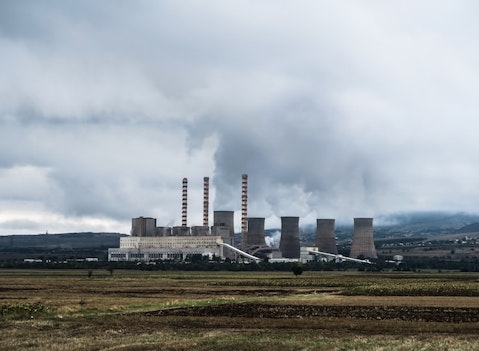
Photo by Jason Blackeye on Unsplash
I returned to a 2-rig program in the DJ Basin late last year requires additional investment but should begin to moderate production decline by the middle of 2023. In our Permian unconventional business, we intend to run an activity program similar to the second half of last year. Our Permian unconventional assets are best placed to deliver production growth to offset marginal declines elsewhere in our portfolio. Overall, 2023 Permian unconventional capital is expected to decline slightly from 2022 due to the initial capital inflow from the Delaware Basin JV. We anticipate that inflation will continue to be a challenge for our industry this year. In 2023, we expect approximately 15% inflation impact on our domestic Oil & Gas business compared to 2022.
As always, we will continue our efforts to reduce and offset inflation by leveraging our supply chain competencies and focusing on continued capital efficiency. Another important aspect of sustainability is the carbon intensity of our operations and what we’re doing to address it. We focus on reducing emissions every day as we progress our pathway to net zero. And we’ve made significant progress over the past few years. Since 2020, our emissions reductions projects have focused on capturing methane and reducing venting and flaring. These projects resulted in a 33% decrease in our estimated company-wide methane emissions from 2020 to 2021 and a 24% decrease in methane emissions intensity of our marketed gas production. We were the first U.S. oil & gas company to endorse the World Bank’s Zero routine Flaring by 2030 initiative, and I’m pleased to announce that our U.S. Oil & Gas operations achieved Zero Routine Flaring 8 years ahead of that target.
That was a major achievement. Our international operations have implemented projects to significantly reduce routine flaring, and we’re on track to meet the World Bank’s target well ahead of 2030. In 2023, we also intend to invest in several unique and compelling Low Carbon business opportunities to advance our net zero pathway. Ongoing construction of our direct air capture facility in the Permian and the development of our large Gulf Coast sequestration hubs, including Pore space certification, will be among our expected investments. We anticipate that our first direct air capture, or DAC, plant will complete commissioning and begin to capture carbon in late 2024 and be commercially operational in mid-2025. This timing is a few months later than our original target.
As we navigate the current supply chain environment and focus on construction sequencing to support faster optimization and the application of new technologies and innovation. Our 2023 capital investment in these Low Carbon businesses is expected to total $200 million to $600 million, subject to third-party funding optionality for the DAC and the timing of projects. We mentioned on our prior call that our net zero ambitions will our funding outside of Oxy’s historical capital allocation program. However, we are prepared to fund our first stack ourselves if utilizing our capital preserves the most value for our shareholders. Our capital plan includes investments in our carbon sequestration business, both through the development of the Gulf Coast hubs we previously announced and through drilling appraisal wells.
Investments in other projects that reduce Oxy Scope 1 and 2 emissions will also continue. As part of our strategy to develop Gulf Coast sequestration hubs, we’re pleased to announce that we will be working with energy transfer low-carbon development to build a pipeline network from point source emitters in the area through our Magnolia sequestration site in Allen Parish, Louisiana. This pipeline will support our point source carbon capture and sequestration business, which we intend to develop along with our DACs, to help medium- and long-term greenhouse gas emission reduction goals for Oxy and our customers. Before turning it over to Rob, I want to reiterate that our 2023 capital plan focuses on projects that best position Oxy for long-term success.
As in past years, we retained a high degree of flexibility, which allows us to adapt to commodity price fluctuations and reduce spending if necessary. Now I’ll turn the call over to Rob.
Robert Peterson: Thank you, Vicki, and good afternoon, everyone. Last year, we repaid over $10.5 billion of debt and retired all remaining interest rate swaps, breaking on our balance sheet and improving our credit metrics as we seek to regain investment-grade ratings. The completion of our $3 billion share repurchase program moved us closer to returning over $4 per share to our common shareholders, which will begin to trigger a redemption of the preferred equity. Our fasting improved financial position, even compared to 1 year ago, enables us to begin allocating a greater proportion of excess free cash flow to our shareholders in 2023. Today, I’ll begin by explaining where we are in terms of partially redeeming the preferred equity, I’ll then detail our redemption mechanics in a scenario where the $4 trigger is met.
The mandatory redemption of deferred equity is triggered with a rolling 12-month common shareholder distribution, which a cumulative $4 per share. This trigger is evaluated daily based on shares outstanding on the day capital has returned. As of today, we have distributed $3.70 per share additional $0.22 per share is required to reach the $4 trigger. In our presentation, we have included an illustrative example of a $100 million distribution to common shareholders after the $4 share trigger is reached. In conjunction with the common distribution, a $100 million mandatory matching distribution versus a half that will be made, of which $91 million will redeem preferred equity principal with a $9 million or 10% premium. In this example, Oxy would incur a $200 million total cash outlay.
This process of mandatory redemption repeats as long as the trailing — or, share trailing 12-month distribution to common shareholders is greater than $4. There is no limit to exceeding the $4 per share trigger through additional distribution to common shareholders. Consequently, even if the trailing 12-month distribution decline, additional distribution to common shareholders will still trigger partial preferred equity redemption. We expect our refreshed share repurchase program to combine with our $0.18 per share quarterly dividend to enable us to exceed the $4 per share trigger to begin redeeming the preferred equity. While the magnitude and pace of the partial preferred redemption and resulting enterprise value balancing will ultimately driven by commodity prices, we expect our shareholders to benefit in a similar way to the value created in 2022 through debt reduction.
I’ll now turn to our fourth quarter results. We posted an adjusted profit of $1.61 per diluted share and a reported profit of $1.74 per diluted share. Difference between adjusted and reported profit was already driven by a noncash tax benefit related to new organization of legal entities. As Vicki mentioned, our Board recently authorized a new $3 billion share repurchase program following the repurchase of approximately 47.7 million shares last year for a weighted average cost of below $63 per share. We exited the quarter to approximately $1 billion of unrestricted cash after paying $1.1 billion of debt and retiring $450 million in notional interest rate swaps. For the year, we completed over $10.5 billion of debt repayment, which eliminated 37% of outstanding principal and resulted in a sizable reduction in interest rate — interest burden.
We estimate that the balance sheet improvements executing in 2022 will reduce interest and financing costs by over $400 million per year. Our proactive debt reduction efforts leveled the company’s profile of future maturities and so that we now — so we have less than $2 billion of debt maturing in any single year for the remainder of this decade. Going forward, we intend to repay debt as it matures and may also reduce debt opportunistically. We repaid approximately $22 million in January and do not have additional maturities until the third quarter of 2024, providing us with a clear runway to focus on returning cash to shareholders and partially redeeming the preferred. In the fourth quarter, we generated approximately $2.6 billion of free cash flow, even with inflation continuing to pressure costs and capital spending.
Domestic operating expenses were higher than expected, primarily due to the impact of winter storm Elliott, equipment upgrades and platform life extension work in the Gulf of Mexico and inflation. Overhead increased as a result of higher accruals related to compensation and annual environmental remediation. Capital spending in the quarter was higher than expected due to inflationary impacts, investments in attractive OBO projects, scheduled changes leading to activity in higher working areas and rig starts for our Delaware JV. We further improved our liquidity position when Oxy became the first company ever to securitize offshore oil & gas receivables and an amendment to increase our accounts receivable facility by 50% to $600 million. In 2022, we paid U.S. federal cash taxes of approximately $940 million, in line with our previous estimate.
As we move into 2023, we expect to have full U.S. federal cash taxpayer as we’ve utilized all our NOLs and U.S. general business carryforward credits. We expect our full year production to average 1.18 million BOE per day in 2023. As it was the case last year, production in the first quarter is expected to be lower than the preceding quarter due to scheduled maintenance turnarounds, primarily in our international operations. We’ll have fewer wells come online in our U.S. onshore business in the fourth quarter, with only about 15% of our Permian wells and 6% of our Rocky wells for the year turning over to production. That said, our overall production trajectory is expected to be smoother in 2023 than the prior year. Throughout 2022, we worked with Colorado regulators and local communities to successfully navigate the permitting process.
Our work positioned us to add back 2 rigs in the DJ by the end of 2022. Given the reduced activity levels over the last few years, our Rockies production is likely to be lower in 2023 last year. Production is expected to stabilize in the second half of 2023 once the benefits from the additional rig picked up in the fourth quarter of last year fully materialize. rules in Colorado typically lead to a pad development approach with a linear time to market cycle as compared to simultaneous operations in other shale plays. This operating environment creates negligible additional costs for our development, but this year is expected to have a noticeable impact on time to market as our activity ramps up. The DJ Basin remains an exceptionally high return asset for Oxy, and we welcome the return of sustaining capital levels to that business, which was predicated by the regulatory certainty and permitting efficiency we are now experiencing in Colorado.
The production sharing contract we announced last year with Algeria is expected to take effect in March. Once the agreement is in place, net barrels to Oxy will decrease by approximately 15,000 BOE per day, which is reflected in our 2023 guidance. We do not expect a material change in operating cash flow because the tax rate were also reset under the new PSC Operating costs across our Oil & Gas business are expected to approximate the second half of 2022 as inflationary pressures remain in our lower-cost DJ Basin production declines. In the Gulf of Mexico, maintenance work to further reduce plan time — planned downtime and extend platform lives will impact operating costs. We are also increasing EOR downhole maintenance work and CO2 purchases.
On a BOE basis, operating costs may increase internationally due to lower reported barrels of the new Algeria contract. 2022 was an exceptional year for OxyChem as the business exceeded $2.5 billion in income. We expect 2023 to be another strong year by historical standards, that is unlikely to match 2022. Caustic soda prices reached all-time highs in the fourth quarter of 2022, but we are now making downward pricing pressures as the macroeconomic environment remains uncertain. PVC pricing fell sharply in the second half of 2022, but has begun to stabilize. As I’ve mentioned before, OxyChem’s integration across multiple chlorine derivatives enables us to optimize our production mix to what the market demands. We remain optimistic about the business, and our capital investments will further strengthen our margins and competitive position.
Looking forward to the rest of 2023 and beyond, we remain dedicated to extending the success of 2022 and advancing our enhanced return framework. I will now turn the call back over to Vicki.
Vicki Hollub: We’re now ready to take your questions.
See also 25 Best Countries to Start a Business and 17 Most Valuable Furniture Companies.
Q&A Session
Follow Occidental Petroleum Corp (NYSE:OXY)
Follow Occidental Petroleum Corp (NYSE:OXY)
Operator: And today’s first question comes from Raphaël DuBois with Societe Generale.
Raphaël DuBois : The first one is about the DAC 1 timing, which seems to have slipped a little bit with operating status now to be reached mid-2025 instead of end 2024. And I was wondering if we should consider that it’s — it means that other DACs, the ones that follow could also be delayed. That will be my first question, please.
Vicki Hollub: No, we don’t expect delays in the other DACs. The delay came because of the supply situation that we’re experiencing today. We expect that since those are further out, we’ll have more time to prepare and to address some of the supply chain challenges that we have today. So we don’t expect the schedule to change.
Raphaël DuBois : Great. And my follow-up is on the $200 million to $600 million CapEx for the Low Carbon. Can you maybe help us better understand why is dedicated for that one? And what is left for other projects?
Vicki Hollub: We haven’t broken out the — that $200 million to $600 million at this point. Richard, do you have anything?
Richard Jackson: Yes. I was just going to add, I mean, to kind of help give you some color on the program. I mean, certainly, some of that is allocated as we started construction for DAC 1 this year and obviously continue on the next couple of years with our construction pace. We do continue to develop our CCUS hubs around the Gulf Coast that we’ve previously disclosed, and we announced with the Midstream partnership today. And then the other piece, and I think it partially answers your first question is continuing to look at our DAC Pre-FEED and FEED work as we go into the South Texas hub. We think that’s meaningful. And so while we’re progressing and optimizing the schedule for DAC 1, in parallel, we’re working with the same innovations and learnings and applying that to our South Texas Hub, which we think we’ll be able to keep us on pace for that development as well.
Operator: And ladies and gentlemen, our next question today comes from David Deckelbaum with Cowen.
David Deckelbaum: I wanted to dig in a little bit more. You talked a bit about reaching this $4 per share return on capital threshold and now looking at the preferreds as this trigger as a priority. How do we think about your view on the returns of capital on retiring preferred versus, say, supplementing that with asset sales as we work through the year, especially as you get beyond the second quarter of ’23 and that trailing 12 months $4 a share benefit kind of rolls off, especially from that notable lump in the second quarter of ’22? How do you think about navigating that? And should we expect you to kind of pull forward other sources of cash to try to stay above that threshold?
Vicki Hollub: Hitting the threshold has been really not a target, but an outcome of a plan that we wanted to execute anyway. Share repurchases is such a critical part of our value proposition that this is the way it has evolved. We’re not really sure what the macro is going to do towards the end of this year. So in terms of what if any asset sales we would do to keep the pace, that really is dependent on the value — what value we see in doing that and what we have available. But I would say right now, we don’t have anything on the list to sell. Of course, anything we have is for sale, it’s for the right price. But there’s nothing that we’re actively marketing right now. And we believe that the second half of the year could potentially bring a macro environment that allows us to continue without engaging in any additional asset sales.
